
HOME
INTRO
SYMBOLS
ALMANAC
ECONOMY
GEOGRAPHY
STATE MAPS
PEOPLE
FORUM
NEWS
COOL SCHOOLS
STATE QUIZ
STATE LINKS
BOOK STORE
MARKETPLACE
NETSTATE.STORE
NETSTATE.MALL
GUESTBOOK
CONTACT US


Dbl click any word in
document for definition.
Vermont State Coat of arms; crest; motto and badge
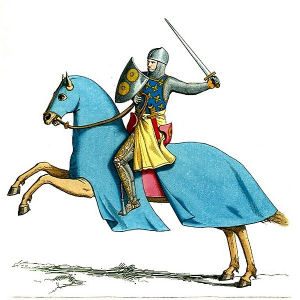
The knight is wearing a surcoat over his armor.
When people engage in conflict, for whatever reason, there is a need to know who is on whose side. As one doesn’t want to run the football over the other teams goal line, in battle one does not want to engage the wrong people on the field.
What is a coat of arms?
Technically a "coat of arms" is the surcoat that medieval knights wore over their armor. The term "coat-armour" is sometimes used.
- More casually, a coat of arms was a unique heraldic design most generally found on a shield that identifies a particular individual... on the battlefield.
Dating back to the mid-12th century (around 1150), the design of a coat of arms is smothered in heraldic language and custom.
- Heraldic design originally concerned itself with the emblems and insignia found on shields and banners during battle.
- The design would be unique to the individual, his family, his country or state, locale, etc. For obvious reasons, men in battle needed to be able to identify the participants.
Here, we are talking about a unique heraldic design that identifies a state.
Understanding the purpose of a coat of arms design makes it easy to understand why states have adopted arms and why so many states display their unique coat of arms on their state flag.
Evolution of the Vermont Coat of Arms
1821
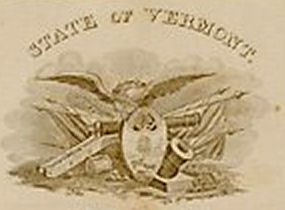
Version of Commission Coat of Arms
About all that can be made out on the shield is the pine tree.
The first appearance of a design resembling today’s coat of arms appeared as an engraving on an 1821 military commission. A military commission is an official document that grants the rank of officer to a member of a militia or the armed services.
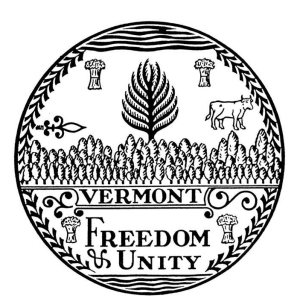
Vermont State Seal
The 1821 engraving took elements of the state seal, most prominently a tall pine tree, and placed them on a shield. The whole was crowned with a stag’s head crest over which an American eagle with outspread wings and the “weapons of war” presided.
The current Vermont seal, approved by a resolution of the General Assembly on February 20, 1779, is identical to the seal referred to in 1821.
According to George G. Benedict’s article, "The Flag," "…a stag’s head had been added for the crest, in 1821 by Robert Temple, Secretary of the Governor and Council, in a design prepared by him and engraved for commissions issued by Governor Skinner to the officers of the State militia."
Versions of the 1821 Coat of Arms were in use from 1821 to 1862, but never standardized by law. Variations included pine boughs beneath the shield, said to represent the pine sprigs worn by Vermonters at the Battle of Plattsburgh in 1814 (War of 1812). Later, the pine boughs were replaced by bird plumes.
1837
In 1837, the Vermont Legislature approved a new design for the state flag. It repealed the Act of 803 and in its stead:
"It is hereby enacted by the General Assembly of the State of Vermont, that from and after the passage of this Act, the flag of this State be thirteen stripes, alternate red and white; that the Union be one large Star, white in a blue field, with the Coat of Arms of the State of Vermont therein."
There was one rather major problem with this. There was no official Coat of Arms!
The Civil War... 1862
As the Civil War began, the need for an appropriate coat of arms that would be defined by law was obvious. Soldiers needed a standard to identify themselves.
In an 1862 letter to the Vermont House of Representatives, a committee of the Vermont Historical Society called for action.
"The investigations of the society lead to the belief that the devices of our Coat of Arms and the State Seal rest wholly upon usage and tradition; and that there is no law, resolution or order extant, establishing the same.
"Some of the devices now in use appear in the first Seal of the State, impressions of which we have as early as May, 1778; since that time the devices have changed with the fancy of every officer that had occasion to procure a new die to impress an official character upon State documents.
"The object of your memorialists is, not to change, but to fix and establish by law. Their mission is to ask the General Assembly that the emblems now emblazoned on our State Flag, and under which our sons now go forth to battle, may be as constant and unchanging as the mountains they portray; and that the devices of the Seal, that attest the power and the faith of our State upon official papers, may remain forever, unaltered.
"We ask that precisely the same emblems, reminding of homes among Green Hills, and that are already of historic renown, may gladden the eyes and incite the hearts of Vermonters 'till the last syllable of recorded time.'"
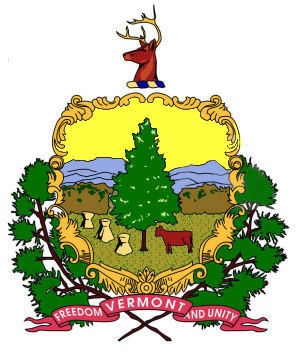
Vermont State Coat of arms; crest; motto and badge:
ALLPOSTERSURL
The result was Act No. 11 of 1862. Chapter 131, "Of the State Arms, Seal and Flag," was written by Professor George W. Benedict using what has been described as "quasi-heraldic" terminology. This is the law as we see it today.
It's not very specific and a painting by Charles R. Heyde at the time was to represent the official version. The Heyde painting was lost, but an 1898 painting was available to replace it.
By the way, if you are asked, Professor Benedict stated that the high mountains are Camel's Hump and Mansfield as seen from a point opposite Burlington. This view was used, according to the professor, because it was thought that this was Samuel de Champlain' first view of the Green Mountains. It was also thought that this would be a familiar view to travelers on Lake Champlain.
Description of the Vermont Coat of Arms
As has been mentioned, the Vermont Coat of Arms was constructed from elements within the state seal. Though some descriptions were written, it's impossible to know exactly what was on the minds of those who chose the elements of the seal and coat of arms. We can make some very good suppositions.
Shield
The shield contains the elements from the seal itself; the pine tree, the sheaves of wheat, the cow, the mountains, the sky and the state motto. Though most of the meaning behind the elements was not recorded, the symbolism is fairly obvious.
- The pine tree represents the forests of Vermont. The tall, straight pine trees were marked for masts for the state's navy.
- The three sheaves represent the vegetative aspects of agriculture, the cultivation of crops and food stuffs.
- The cow represents the animal aspects of agriculture, the breeding of cattle for dairy products and meat products.
- The mountains most certainly represent the Green Mountains of the State. Indeed, the author of the law is said to have remarked that the high peaks were Camel's Hump and Mount Mansfield.
- The yellow sky, prescribed by law, can represent the warmth and vitality provided by the sun.
Three items were added to the shield to complete Vermont's Coat of Arms.
- A scroll, beneath the shield, that displays the state motto;
- Two pine branches offer support to the shield. This "badge" is reminiscent of the pine sprigs that soldiers wore at the Battle of Plattsburgh in 1814.
- The crest, a stag's head displayed on a blue and yellow scroll sits atop the shield. In heraldic terms, the stag's head can peace, harmony or represent a passivity, unless provoked.
Vermont Law
The following information was excerpted from the Vermont Statutes Annotated, Title 1, Chapter 11, Sections 491-492.
TITLE ONE. GENERAL PROVISIONS
CHAPTER 11. FLAG, INSIGNIA, SEAL, ETC.
1 V.S.A. § 491 (2012)
§ 491. Coat of arms; crest; motto and badge TEXT
The coat of arms, crest, motto and badge of the state shall be and are described as follows:
(1) Coat of arms. -- Green, a landscape occupying half of the shield; on the right and left, in the background, high mountains, blue; the sky, yellow. From near the base and reaching nearly to the top of the shield, arises a pine tree of the natural color and between three erect sheaves, yellow, placed diagonally on the right side and a red cow standing on the left side of the field.
(2) Motto and badge. -- On a scroll beneath the shield, the motto: Vermont; Freedom and Unity. The Vermonter's badge: two pine branches of natural color, crossed between the shield and scroll.
(3) Crest. -- A buck's head, of natural color, placed on a scroll, blue and yellow.
1 V.S.A. § 492 (2012)
§ 492. Design of coat of arms
The secretary of state shall keep in the archives of his office a representation of the coat of arms according to the foregoing description.
Sources...
"Vermont Statutes Annotated." LexisNexis, a division of Reed Elsevier Inc.. LexisNexis, a division of Reed Elsevier Inc., n.d. Web. 20 Feb 2012. .
"Vermont Coat of Arms." Vermont Department of State. State of Vermont, n.d. Web. 24 Feb 2012. .
Benedict, George G. "The Flag." The Vermonter, a Slate Magazine. Mar 1902: 105. Print.
Shearer, Benjamin F. and Barbara S. State Names, Seals, Flags and Symbols: A Historical Guide Third Edition, Revised and Expanded. Westport, Conn: Greenwood Press, 3 Sub edition, 2001.
Additional Information
Vermont Coat of Arms: Vermont Department of State: Emblems & Vermont State Flag.
More symbols & emblems: Complete list of official Vermont state symbols from NETSTATE.COM.
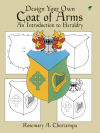
Desing Your Own
Coat of Arms
Rosemary A. Chorzempa
Design Your Own Coat of Arms, by Rosemary A. Chorzempa. 48 pages. Publisher: Dover Publications (July 1, 1987) Reading level: Ages 9-12. Design your own personal coat of arms. Detailed, easy-to-follow instructions make it easy even for beginners to fashion emblems that reflect family origins, traits, and accomplishments. Decorate plates, mugs, and stationery or create wallhangings, sew-on patches, T-shirt decals, pin-on badges, and much more.
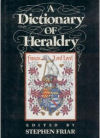
Dictionary of
Heraldry
Stephen Friar
Dictionary of Heraldry, by Stephen Friar. 384 pages. Publisher: Harmony Books; 1st edition (September 24, 1987) A dictionary, containing defintions of attributes (special features of a charge: beak, tongue, claws, etc...) and attitudes (body position of a charge) of heraldic charges, and how to blazon and emblazon armorial bearings. Using a two color plate, Friar walks the reader through the blazon (and emblazon) of arms to help the reader understand the order of precedence. Nicely laid out in alphabetical order with clean, crisp drawings. Historical information regarding a subject as needed.
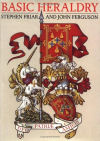
Basic Heraldry
Stephen Friar
Basic Heraldry, by Stephen Friar. 200 pages. Publisher: Quadrillion Pub (February 1, 1999) This introduction to heraldry describes its beginnings in ancient times and its history from the age of chivalry to the modern period. Crusader's pennons and banners, helms and seals of conquerers, livery collars, and the development of the Union Jack are among the dozens of drawings offered in this well-illustrated volume. Degrees of British peerage (duke, marquess, earl, viscount, and baron) are briefly explained and accompanied by artistic renderings of the coronet and coronation robes. The section titled "Orders of Chivalry" discusses the Order of the Garter, the Order of Bath, and others. Notes on civic, corporate, and ecclesiastical heraldry complete the history.
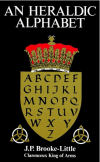
An Heraldic Alphabet
J. P. Brooke-Little
An Heraldic Alphabet, by J. P. Brooke-Little. 234 pages. Publisher: Robson Books; 3rd edition (April 15, 1997) 'A most useful dictionary of heraldry and heraldic terms. Those with a casual interest in the subject will find the comprehensive descriptions helpful and will be able to acquire the language of heraldry through them. But the serious student too will find this a useful reference book' - The Times Literary Supplement
Illustrated with over 300 drawings, An Heraldic Alphabet includes general chapters on such topics as the birth of heraldry. Clear, definitive and precise, An Heraldic Alphabet is the essential glossary for all students of heraldry and for those thousands of people intrigued by this engrossing subject.
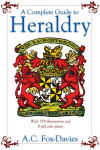
A Complete Guide to Heraldry
Arthur Charles Fox-Davies
A Complete Guide to Heraldry, by Arthur Charles Fox-Davies. 656 pages. Publisher: Skyhorse Publishing (May 1, 2007) Heraldry, the study of family crests and medieval coats of arms, is a science and art steeped in the tradition of familial honor and shaped by strong cords of ancestry and origin. Here Arthur Charles Fox-Davies describes the origin and importance of heraldry and the myriad elements and designs used in the coats of arms of England and Scotland. He explores the meaning of symbols like birds, fruit, flowers, crowns, coronets, flags, and mottoes, and extensively discusses their derivation and significance. With 770 detailed illustrations designed to aid in tracing family lineage, this book will help historians, genealogists, collectors, and anglophiles sift through the records of history and better understand the past.

